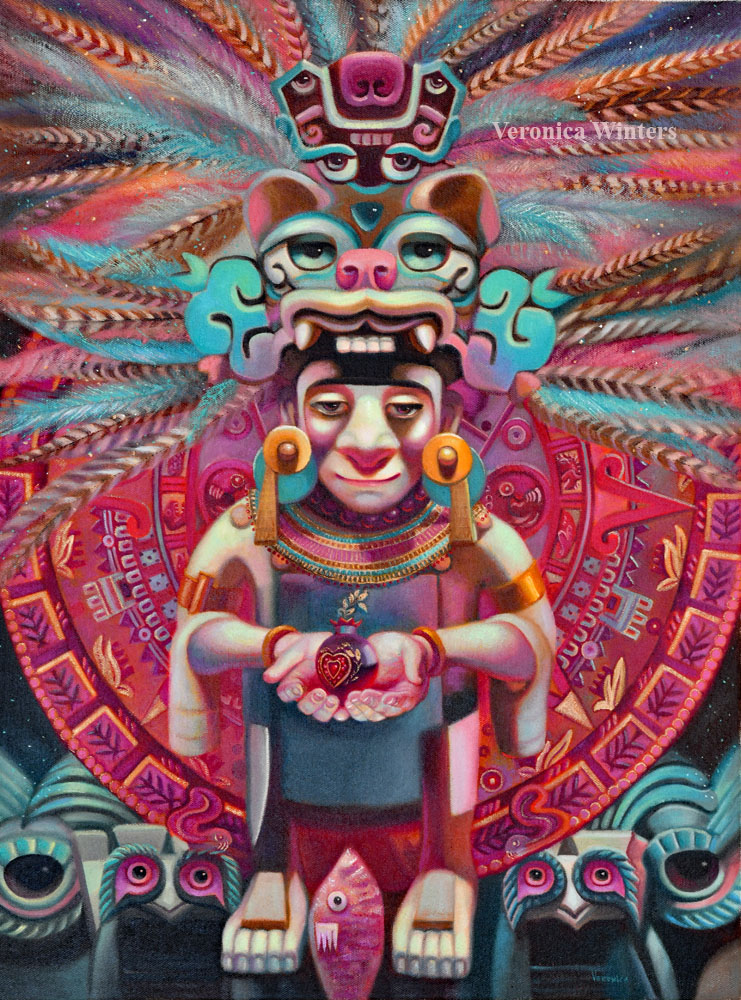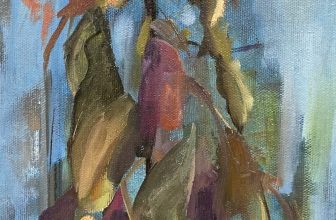
What Does Cacao Symbolize in Art?
If you’ve ever cradled a warm mug of hot chocolate on a chilly fall or winter evening, you know that cacao does more than just taste amazing—it whispers ancient stories right into your soul. Let’s dive into cacao’s mythic roots in Mayan art and beyond, exploring how this humble bean has bloomed into a powerhouse symbol of love, sharing, and earthy vibes. Visionary artists often weave it into their work to evoke its ancient roots and deep connections to the earth. This sacred plant has been respected and admired for centuries as a bridge between the physical and the spiritual. Its symbolism extends beyond taste or utility, reaching into themes of healing, connection, and gratitude. Let’s sip on the history and let it inspire our own creativity!

The Mythic Origins of Cacao

Legends tell of cacao as a divine gift, typically regarded as sacred by ancient cultures like the Maya and Aztecs. It was seen as a bridge between humans and the gods, believed to open portals to higher realms.
The cacao tree’s origin stories emphasize its mystical properties. Some myths describe it as sprouting from the blood of deities, while others portray it as a key to understanding the cosmos. These tales continue to inspire artists who seek to channel its otherworldly significance. In visionary art, cacao frequently appears as a symbol of spiritual awakening. It connects the viewer to a lineage of wisdom, honoring its role as a plant that nourishes both body and soul.
Imagine this: deep in the steamy jungles of Mesoamerica, around 2000 BCE, the Olmec folks were already grinding cacao beans into a frothy elixir fit for the gods. Fast-forward to the Maya, who wove cacao mythic roots in Mayan mythology into their epic tales like the Popol Vuh. Here, hero twins Hunahpú and Xbalanqué venture to the underworld, emerging with cacao as the “first fruit of the maize tree”.. A snack food today, it symbolized life from death, a bridge between worlds in ancient world.
The Aztecs cranked up the drama, crediting their feathered serpent god Quetzalcoatl for gifting the cacao tree to humans after a theft from paradise. In symbolism of cacao in Aztec rituals, it was blood-red drink for warriors and priests, linking the heart’s pulse to divine energy. These myths painted cacao as a cosmic connector, turning everyday beans into badges of fertility, abundance, and that wild, otherworldly magic.

600-800 CE. Image copyright: Denver Art Museum
This cup paints a picture from the elite, Mayan palace life. Their payment to God includes fans, textiles, and three hefty bags of cacao or chocolate beans. Such colorful, ceramic drinking cup belonged to the elite.
In ancient Maya art, check out the Rio Azul vessels: stunning burial pots etched with cacao hieroglyphs, showing elite rulers sipping frothy brews on thrones. These were cups for the elites as portals to cacao symbolism in ancient Mayan art, blending death’s mystery with life’s abundance. Aztec codices glow with Quetzalcoatl cradling cacao trees, his serpentine body winding through vibrant pages that scream ritual power and divine generosity. https://www.mexicolore.co.uk/maya/chocolate/blood-of-the-gods

This is the art from the polychrome Classic Maya drinking cup. While the painting style first appeared in Guatemala, these Chamá-style vases were a feature of palace life in the Maya world in the eighth century, according to the Met. Used in feasting, gift exchange, and funerary offerings, the Chamá style cups depict the throne’s pseudo-glyphs. The gifts to the king lie under the throne. Located between the king and the visitor, a cylindrical vessel with a foaming liquid shows either a type of fermented corn beverage or savory chocolate.

THE CODEX ZOUCHE-NUTTALL is one of eight surviving pictographic codices of the Mixtecs, an advanced Mesoamerican culture. The codices provide a glimpse into the life of the upper classes of society and mention cocoa frequently – here, for example, a bride hands her bridegroom a cup filled with the chocolate drink.
A Quick Scoop of History: From Sacred Brew to Global Indulgence
Cacao’s adventure didn’t stop at pyramids. By 600 AD, Maya nobles slurped it from ornate gourds during weddings—sharing a cacao-infused sip as a vow of united bloodlines and endless prosperity. Aztecs upped the ante, using beans as currency and reserving the royal xocoatl brew for elites. A gourmet food, cacao beans were often used as money in Mayan culture.
Then came the Europeans in the 1500s, post-conquest, who rebranded it “food of the gods” (hello, Theobroma cacao scientific name). What started as a bitter ritual drink morphed into sweetened luxury, fueling trade routes and even early stock markets. Through it all, cacao carried its historical journey of cacao from Aztec rituals to Renaissance paintings, evolving from underworld treasure to a sip of sophistication.

Fast-forward to Europe, and Jean-Etienne Liotard’s 1740s The Chocolate Girl captures a servant girl with a steaming cup of hot chocolate, her rosy cheeks hinting at cacao’s newfound allure as a flirtatious luxury. Or peek at his series of ladies in finery pouring hot chocolate—pure historical symbolism of chocolate in European paintings, where the brew symbolizes cozy intimacy and exotic escape. (Jean-Etienne Liotard, A Lady Pouring Chocolate or A Dutch Girl at Breakfast, c. 1744, Rijksmuseum, Amsterdam).

Reciprocity and the Spirit of Giving in Contemporary Visionary Art
In indigenous traditions, cacao is a sacred offering. Its cultivation and sharing represent reciprocity, a deep exchange of gratitude and respect between people and the earth. In contemporary visionary art, it serves as a metaphor for creative flow.
Visionary artists usually reflect this spirit of giving in their work. Cacao may be shown alongside rituals or communal gatherings, highlighting its role as a tool for unity and abundance. This theme challenges viewers to reconsider their relationships with resources and with one another. Through the lens of cacao, art invites us to act with intention and gratitude, mirroring the plant’s role in ceremonial life. Visionary art sometimes uses cacao to represent the interconnectedness of life. You’ll see it woven into depictions of lush jungles, ancestral roots, or cosmic cycles, grounding its meaning in themes of balance and renewal.
By drawing attention to cacao’s connection to the land, artists highlight the importance of honoring nature. The imagery becomes a call to care for the planet, much like indigenous practices that view cacao as a sacred responsibility.
During a solo drawing session, journal about what “abundance” means to you right now. These tiny rituals honor cacao’s legacy without overwhelm, weaving its mythic magic into your everyday muse.
Mindful Sourcing and Community Rituals
Sourcing cacao ethically is integral to preserving its sacred meaning. Communities that cultivate it often do so with care, embedding rituals into its harvest and preparation.
Visionary art reflects these rituals, showcasing the hands of farmers, the beauty of the cacao pod, or the process of its transformation into drink or food. These details ground the work in the real-world impact of mindful consumption.
The emphasis on ethical sourcing reinforces cacao’s deeper message of balance. Through honoring the communities behind it, both art and practice align with its spirit of respect and reciprocity.
Savoring Cacao Energy Today: Modern Brands Honoring Cacao Traditions
Some chocolate brands are taking thoughtful steps to honor the cultural and spiritual roots of cacao. They go beyond flavor, focusing on sustainable practices and ethical sourcing that reflect respect for its origins.
For example, Purdys Chocolatier supports sustainable cacao programs and farmer education, helping preserve traditional methods and community well-being. Their approach blends quality with a deeper purpose.
When they value where cacao comes from, these brands bridge commerce with cultural reverence. Their efforts align with the same principles celebrated in visionary art – connection, respect, and gratitude for the hands and lands behind each cacao bean.
There you have it—cacao, the ultimate art inspirer, from underworld gifts to heart-hugging mugs. Cacao’s symbolism in visionary art offers a bridge between ancient wisdom and modern creativity. It invites us to reflect on connection, healing, and gratitude, all while honoring the sacredness of the natural world.
This simple yet profound plant continues to inspire artists and communities alike. In its presence, we’re reminded of the beauty that emerges when we approach life and creativity with an open heart. What’s your favorite way to let cacao spark your creativity? I’d love to brew up some ideas together! 🌱🍫
Further reading:







